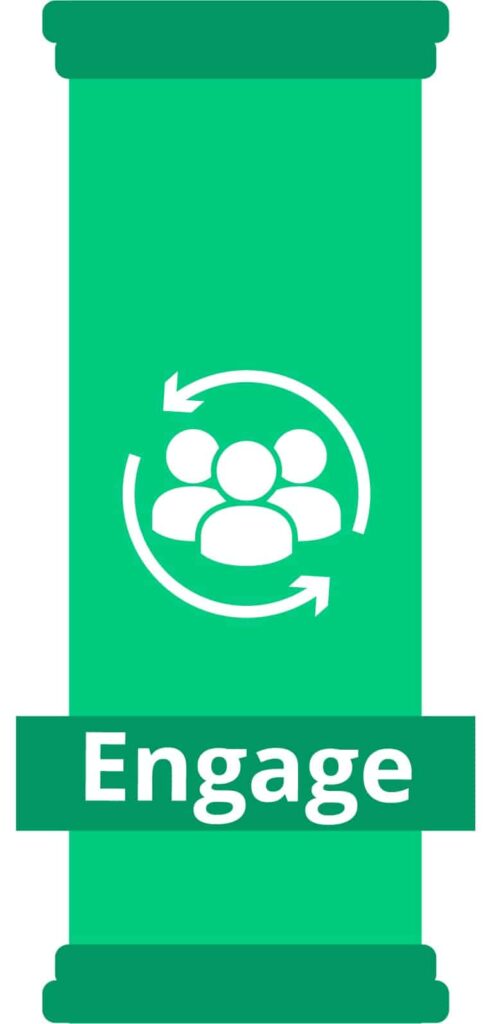Editor’s Note: Given the lingering questions surrounding employee disengagement and the connection to customer loyalty, The Wise Marketer has put together a new thought leadership series we hope will shed some light on the topic. We have asked the Employee Engagement experts at Hinda Loyalty to offer a framework for understanding and attacking the issues facing so many of our readers. The 5-part series began with an introduction to The Four Pillars of the New Employee Relationship. The first pillar, Attracting the Right Personnel, was published previously.
The next entry in the series focuses on the Second Pillar: Engaging the Employee Base. Reader participation and feedback is always welcomed. We’ll continue the series throughout the summer and conclude with a webinar (registration available here) bringing it all together.
By: Theresa Thomas, CLMP™, Hinda and Ric Neeley, Hinda
The TV show Star Trek: The Next Generation featured veteran actor Patrick Stewart as the Captain of the Starship Enterprise. One of his iconic lines was the command “Engage”, indicating to the helmsman to engage the engines and take off to whatever new adventure awaited. While Captain Picard can command someone to engage, you can’t do that with employee engagement. This is the 2nd pillar in our 4-part series: “The 4 Pillars of the New Post-COVID Employee Relationship.”
What is Employee Engagement?
Employee engagement first appeared conceptually in the 1990s, based on the work of William Kahn and was defined as:
"…the harnessing of organization members' selves to their work roles; in engagement, people employ and express themselves physically, cognitively, and emotionally during role performances."
Employee engagement is critical. The cost of having employees makes up a huge chunk of a company’s operating budget, so any reduction in costs — either through efficiency of work, reduced turnover, faster onboarding, etc. — will reap HUGE rewards for a company.
But Employee Engagement in 2022 is Different
The professor who coined the term “The Great Resignation”, Anthony Klotz, also said:
"From organizational research, we know that when human beings come into contact with death and illness in their lives, it causes them to take a step back and ask existential questions." Klotz continued, "Like, what gives me purpose and happiness in life, and does that match up with how I'm spending [life] right now? So, in many cases, those reflections will lead to life pivots."
After 2 years of COVID lockdown, personal human losses and illness, virtual work, and stress caused by family maintenance problems such as available day care or the loss of a job, employees are pivoting. And that pivot means impacting employee engagement just got messier.
Today’s “New Employee Relationship” must now include:
- Greater work-life balance
- Ongoing professional skills development
- Flexibility in what, where, and when employees work
- Resources and education that impact the individual and family-life experiences of their employees — emotionally, financially, socially, and in their career
What does all that mean for a company trying to create a together engagement between their employees and the company? It means a great focus on specific, personalized, and flexible benefits, work structures, work locations, and flexible hours.
How Can You Drive Engagement Today and in the Future?
First of all — you can’t do what you did before. It is not the same world inside, or outside, the corporate bubble.
Key Engagement Initiatives Needed Now
#1 – Engagement is about recognition and appreciation
Every survey and study about employee engagement and retention shows that recognition and appreciation is one of the cornerstones of great companies and great employees. Making sure people KNOW they are appreciated and shown the recognition they deserve is probably the single most important thing you can do. Train your managers on how to do recognition right (there is a right and wrong way), allow your employees to recognize each other through peer-to-peer recognition, install an engagement platform that allows employees to see how others are recognized and appreciated as part of the company basic values. This should be job one before doing anything else.
#2 – Engagement is about human conversations
Today’s employees get all kinds of texts, slacks, emails, updates, etc. Unfortunately, if you’re only using digital tools, you’re missing the one thing that really gives engagement its power. The human side of things.
Yes, you should use all those methods of communication. But don’t ONLY use them to discuss progress on a project or a problem that needs to be addressed. Have a conversation. If you’re back at the office don’t just send an ecard. Walk down/up/over to the person's location and chat with them AND send the ecard. If they aren’t located where you can see them in real life. Make a call. Make a zoom — whatever works in your organization. Use this time to recognize their efforts. Add the human to the digital for real impact.
And don’t just talk about work. Talk about them. What is going on in their life outside the work bubble? Let the employee know they are important enough for you to take time for a one-on-one. They will appreciate it.
#3 - Engagement begins before the employee is even hired.
As mentioned in our article on Pillar #1 of the New Employee Relationship, your employer brand precedes you and is the foundation upon which every new employee builds their own ongoing connection with your company. Employee engagement relies on trust and transparency. Do what you say you will do and make sure people know you’re doing it.
#4 - Engagement starts at the top — and at the bottom
Most companies sideline employee engagement to HR. But most employees look to the executives in a company to model the brand they bought into when they were hired. “Do as I say not as I do,” can’t be a company’s engagement plan. Top-down engagement is just that — executives being part of the engagement discussion or using the engagement platform. That’s how you get the top-down approach going.
Traditional surveys allow you to get the “bottom up” information. The survey is great at assessing the employee mindset. Surveying your employees communicates you’re interested in their point of view and are working to better the company/employee relationship. But don’t stop there. Act on the information. Employees want to see their input is valued and implemented. Do the work.
Employees are looking for more accountability and visibility in their management and managers. COVID taught us that engagement is human relationships. It’s about connections and caring.
#5 Upskilling and growth
A study highlighted on the Leftronic blog showed 70% of employees believe they lack the skills needed to do their job. When they can’t do the job, they are, by definition, disengaged. And disengagement costs approximately $550 billion. But companies that invest in training show a 21% greater profit.
When people are competent and create value, they are engaged.
Investments in training are investments in engagement.
The Other 1,000 Engagement Tips
We’ve listed 5 engagement activities you can use to improve your employee engagement and therefore improve retention and improve overall employee performance (and by extension company performance.)
The problem is there are as many engagement strategies as there are people. Each employee will engage differently. And that is why the next article in our series, “The New Post-COVID Employee Relationship — Pillar #3: Transmit”, will get into how your managers play a crucial role in creating engagement and retention by finding out those 1,000 other engagement needs.
Machines can’t do human work. Managers must do that. And we’ll explain that in our next post.
Don’t Forget - Get Priority Access
If you didn’t do it with either of our first two post in this series, then take a minute and click here to sign up for a complimentary eBook and a reserved spot for our webinar around the 4 Pillars. The webinar will cover all the information in the whole series and during which you’ll have the opportunity to ask questions and engage in dialogue that will help you drive greater employee engagement and advocacy.





